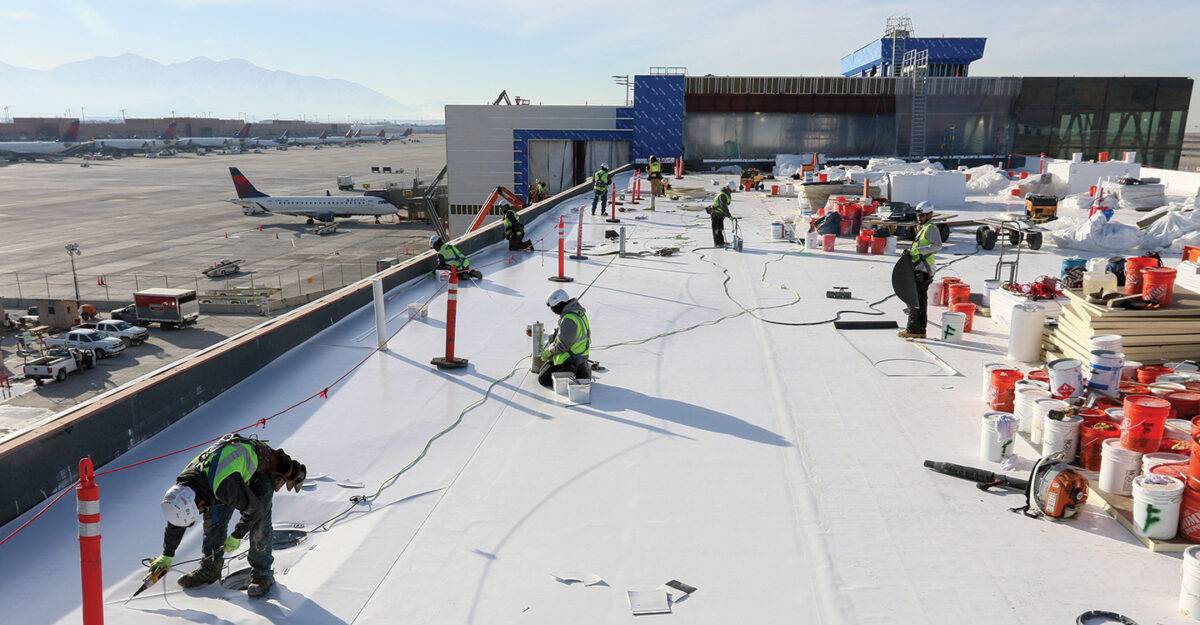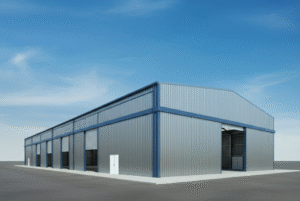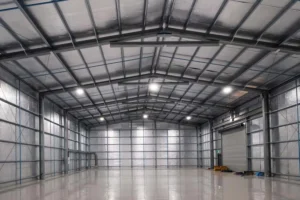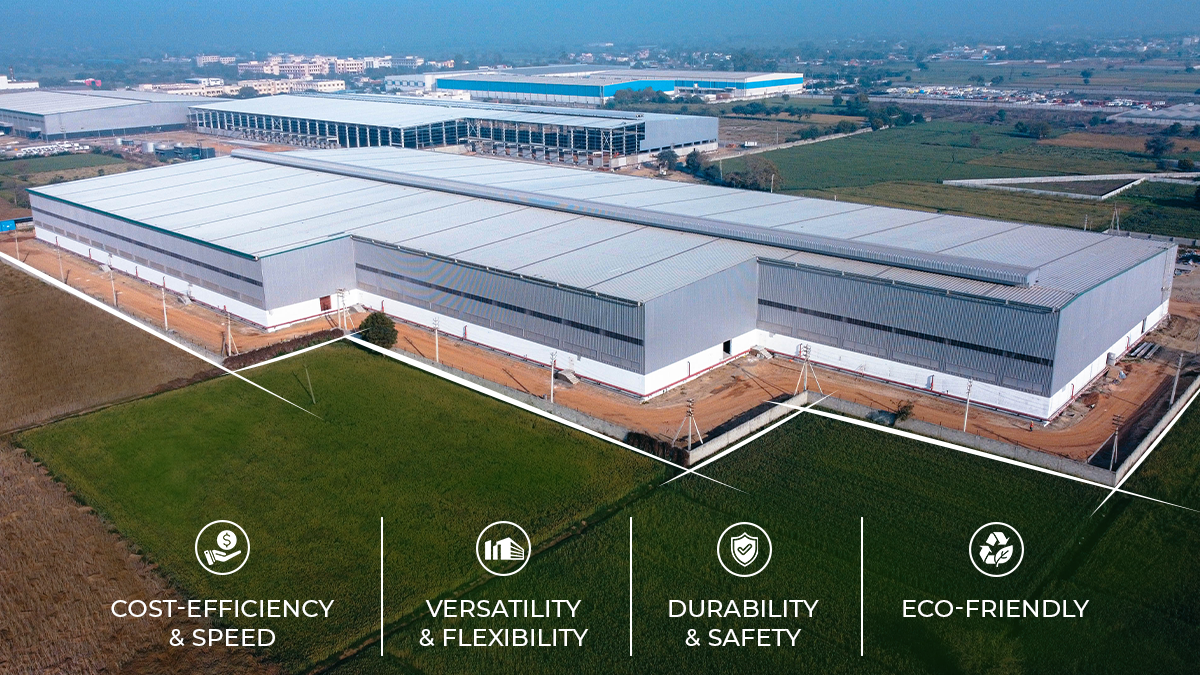
The Inspiration in Finishing the $5B Salt Lake City Airport Rebuild
[ad_1]
✕
“You need to finish.” That was Michael Williams’ parting message to his friends and team building the new Salt Lake City International Airport, including Brian Stetson and Kevin Fauvell. Even from the hospital, where he died in may, he focused on the job. Stetson, who replaced Williams as director of the $5.2-billion capital program, recalls telling the team: “We said we have a commitment to finish this program, and we do it for Mike. we will deliver it the way he laid out the plan. It’s our rally cry: Deliver this thing.”
The dozen-year delivery is almost complete, with about $370 million in construction left to go. The fourth and final phase of the nearly 300-acre greenfield airport is scheduled to finish in 2026. It consists of adding 16 gates to the eastern portion of Concourse B, bringing the total number of gates at the new airport to 94. Final components of the third phase are wrapping up, including installation of jet bridges and paving.

Overcoming challenges such as an earthquake, the pandemic and building atop an ancient lakebed, crews are working on the last set of gates for the new airport.
Photo courtesy of SLC Airport
The project’s four phases overlap, with staggered delivery of components. Phase one, which finished in late 2020, included the 909,000-sq-ft central terminal building and western sections of the 3,700-ft-long Concourse A and 4,300-ft-long Concourse B.
Phase 2, completed in 2023, involved demolishing the six-decade-old original airport, completing the east portion of Concourse A, and beginning work on the Central Tunnel (ENRMS 7-25/8-1/22, p.34). Major components of the third phase included completion of the 1,000-ft-long Central Tunnel connecting the two concourses, and a plaza for Concourse B, which all opened in fall 2024.
“We’re getting pretty close to the end of the program,” says Fauvell, project director for the joint venture of Holder Construction and Big-D Construction (HDJV). HDJV oversees various aspects of the redevelopment, including rental car facilities, the central terminal, Concourse A, the parking garage, roadways, tunnels, utilities and airfield paving under a construction manager-at-risk (CMAR) contract. A joint venture of Austin Commercial and Okland built Concourse B under an approximately $545-million CMAR contract.
“We’re opening up five gates this October,” says Fauvell of Phase 4. The remaining five gates of Phase 3 will also open this fall. “The rest of the building will open in October next year and that will be the last major vertical construction. We’ll be paving a bit through early 2027.”


-2_ENRready.jpg)
In a final big push, the last batches of gates for the new airport will open this October and the following fall.
Photos courtesy of SLC Airport
*Click the photos for greater detail
Stetson notes that key ancillary projects include a baggage handling expansion that includes 7 miles of conveyer belts with 45-in. widths to accommodate oversize baggage such as skis. “We are adapting the system for anticipated growth,” he says. “We’re driving to complete this alongside the main building.”
“We’re adding a second screening area with equipment and an associated construction baggage conveyor,” he adds. “The new inspection station will be redundant to the main system and adds additional screening capability for oversize baggage. It will happen along with the rest of the facilities in 2026.”
A 34,000-sq-ft Delta Air Lines lounge and a 16,000-sq-ft American Express lounge will also open this fall, with a 6,700-sq-ft United Airlines lounge to open next year.



The greenfield airport consists of a new main terminal and two concourses, for which new gates are built and opened in phases from 2020 through 2026.
Photos courtesy of SLC Airport
*Click the photos for greater detail
Phasing Out
Phase 2 components included a six-month demolition of the old airport. Out of 280,000 tons of resulting material, 85% was reused on site. Concrete was ground into onsite backfill material while steel and other components were sent to offsite recycling plants.
Overall construction included ground stabilization measures to accommodate SLC’s location in a seismically active former lake bed. Hundreds of 3-ft-dia holes, laid out in 10-ft by 10-ft grids and drilled 45-ft deep, were pressure-filled with small stones to prevent liquefaction in the event of an earthquake, such as the magnitude 5.7 event that rattled Salt Lake City in March 2020.
The building and tunnels are founded on a combination of driven composite and H-piles, averaging depths of 65 ft to 75 ft. The south concourse extension contains an estimated 5,800 tons of rebar structural steel and 17,657 cu yd of concrete, while the Phase 3 extension to the north concourse will require 3,000 tons of steel and 8,500 cu yd of concrete. Phase 4 involves 15,900 tons of steel and 79,500 cu yd of concrete.
Constructed by cut-and-cover, the 106,140-sq-ft Central Tunnel includes “the River”—a membrane sculpture made up of individual aluminum-framed “fins” wrapped with a fabric material. A playlist of songs chosen by artist Gordon Huether provides an ambient experience for people traveling between Concourses A and B. The sculpture is one of many artworks integrated throughout the airport.
_ENRready.jpg)



The artist Gordon Huether’s works have been integrated into the airport construction for over a decade, including clockwise from top, the Peaks (2023), Northern Light (2024), the Canyon (2024) and the River Tunnel (2024). The latter connects Concourses A and B and includes ambient sound.
Photos courtesy of Gordon Huether
*Click the photos for greater detail
With a water table just 7 ft below the surface, crews utilized sheet piles and a dewatering system to excavate 65 ft deep. Separate tunnel cells accommodate high-speed baggage systems, central utility plant distribution and the future addition of an on-air automated people mover in addition to the six moving walkways.
The 22 gates of the Concourse A extension opened in spring and fall of 2023. The staggered opening of Concourse B’s Phase 3 gates in 2024 and this year are enabling the airport to phase out the last of its temporary “hardstand” operations, where passengers access parked aircraft via shuttles. When the remaining gates of Concourse B’s east side extension open, the new airport will have a total of 94 gates ready to accommodate growth. The airport had a record-setting 28,364,610 passengers in 2024, representing a 4% increase from 2023.
Those passengers experienced an array of artwork at the airport, much of it created by Huether in an ongoing task order contract that began at the outset of the new airport construction.
Michael Williams, 72, was ‘Visionary’ for SLC Airport

Williams
Michael Williams, Salt Lake City International Airport’s redevelopment program director, who project officials confirmed died May 12 of cancer at 72, emphasized the importance of a truly integrated team and “an owner who is involved day-to-day,” ENR wrote in naming him one of its Top 25 Newsmakers in 2022.
A veteran of transportation projects for over four decades who had led the effort since 2012, he “really drove this program and inspired us to be where we are right now,” says Brian Stetson, who succeeds him as program director.
Hired by Salt Lake City airport as an independent program director, Williams created the plan to demolish all three concourses concurrently while keeping the gate count high enough to serve passengers—an innovation that sped up the program’s second phase by nearly two years. Phase 1 opened under budget in 2020.
Stetson notes Williams’ ability to discuss complex project details with C-suite executives and other high-level stakeholders—and an hour late, rap with site workers about tile installation. “He was such a big part of the project and my own career,” says Kevin Fauvell, vice president of Holder Construction, who worked with Williams for 16 years. “He touched a lot of lives.”
Williams’ airport megaproject management skills were honed from prior roles on the $1.4-billion international terminal at Hartsfield-Jackson Atlanta International Airport and the $508-million Terminal A Redevelopment at Boston Logan International Airport.
“Mike was a legend,” says Gordon Huether, who worked with Williams from the beginning to incorporate his artwork into the SLC program. “He was an advocate, a champion, a visionary. I don’t believe the airport would be what it is without him being at the helm.”
By Aileen Cho
Flights of Fancy
Art and architecture were integrated from the beginning of the rebuild, “whether we provided the backdrop for the art, or visa versa,” says Brian Cook, principal and practice leader for the Salt Lake City office of HOK, the lead designer. “We worked seamlessly to complement each other.”
For example, HOK helped modify shop drawings for such installations as “Canyon 2.0,” “Northern Light” and “the Falls” to ensure constructability, says Huether. As consulting artist for the airport, he helped curate the art collection, working with HOK to map out where each of the 135 chosen art pieces would be displayed. He also assisted in the selection of the art concepts for the Whimsy Walls, which adorn 24 restroom walls in the consolidated terminals, and designed and installed the new SLC Art Wall, located in the security screening area. Additionally, he oversaw the refurbishment and reinstallation of existing iconic airport installations such as “You Are Here,” “World Map” and “Flying Machines.”
The installations are construction projects in and of themselves. For example, the Hoberman Arch is a 72-ft-wide x 36-ft-high mechanical curtain that was originally installed for the Medals Plaza in downtown Salt Lake City for the 2002 Olympics. The semi-circular aluminum structure weighs around 31,000 lb and comprises 4,000 pieces put together as 96 connected panels with 13,000 steel rivets. The panels vary in size with the largest being 5-ft wide x 9-ft high.
At some point, the arch ended up disassembled and abandoned in a yard, says Huether. “There were missing pieces. It was a Humpty Dumpty moment.” Working with the original artist, Huether’s crews fabricated the parts and rebuilt the arch.
Similarly, You Are Here is a stained glass window that once hung in the old international terminal and also required new components and a new aluminum frame.
“We have a network of professionals in different fields such as a structural engineer out of Phoenix and a fabricator in Germany,” says Huether. “I put a cardboard model on the table, and they take it from there. What material could it be? What kind of bolts, welds, plates, foundations? Then we bring [the model] to the airport [construction and design teams] for peer review.”
In 2023, the airport unveiled his 10-story-high artwork “the Peak,” which stands at the airport entrance. The 90-ft-tall, 75-ton weathered steel installation evokes the Wasatch mountains, Utah’s five Indigenous tribes and the five elements.
Cable-suspended sculptures of 3,000 swallows and airplanes will adorn the ends of Concourse B after installation this summer and next year, says Huether. He estimates that the program includes some $30 million worth of investment in his artwork over the past decade.




The new airport’s art installations, including Huether’s the Falls (2020) (bottom right) reflect its location, which includes the Wasatch Mountains.
Photos: (Top left and right) HOK, Bruce Damonte; (lower left) courtesy of SLC Airport; (Bottom Right) The Falls by Gordon Huether, courtesy Salt Lake City International Airport
*Click on the photos for greater detail
Public art in airports is “part of a trend to make airports more than processors of people and bags,” says Stanis Smith, a strategic consultant and former executive with Stantec. “The leading airports understand that a happy passenger is unstressed and in an environment they enjoy being in. With less stress, they are more likely to [spend money at airport concessions].”
Moreover, airports compete for passenger traffic and “want to differentiate themselves,” he adds. An example is the Changi Airport in Singapore, which is one of the busiest airports in the world despite its location in a small city-state. Due to its attractions, “passengers choose to connect through Changi.”
Toni Sikes, founder and CEO of CODAworx, a tech platform that connects artists and clients, notes that the $19-billion program to rebuild New York City’s John F. Kennedy International Airport includes $25 million for public art—integrated from the beginning just like in SLC. “Artwork can be a wayfinder at airports,” she notes. “A sculpture is where people can meet up.”
Smith, whose clients include JFK Airport, adds that one of the JFK installations has complex geometry, and “the contractor is great at doing mockups on site, helping us coordinate and integrate. A lot of it is very detailed work.”
Sikes agrees, noting that one of her company’s books on public art showcases examples at various airports. “To do these major pieces requires fabrication and installation,” she says. “Technology is also involved. Creative engineers want to be working with artists, and artists are really becoming involved in infrastructure projects.”
[ad_2]
Source link
Post a Comment
You must be logged in to post a comment.







